#ravanhatta
Explore tagged Tumblr posts
Text
THE ORIGIN OF MUSICAL INSTRUMENTS
Music has been an integral part of human culture for centuries, and the evolution of Musical Instruments has played a significant role in shaping the diverse sounds we enjoy today. From ancient times to the modern era, various instruments have emerged, each with its unique history and cultural significance. Musical instruments have captivated audiences across different cultures and continue to be cherished for their distinct melodies and harmonies.
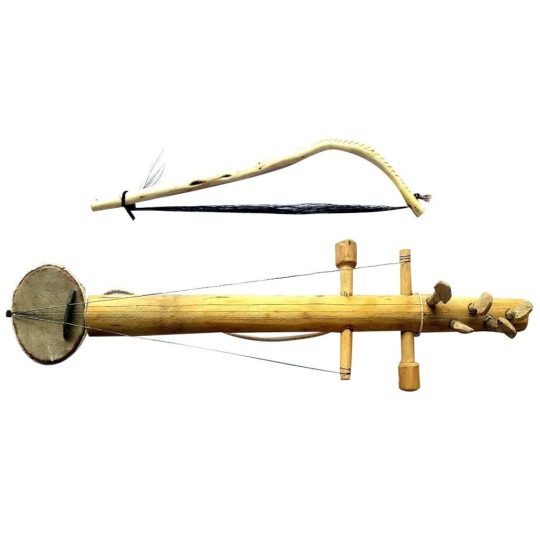
The Ravanhatha, also known as the Ravanhatta, is an ancient stringed instrument that originated in India. Its name is derived from two words: “Ravan,” referring to the mythical demon king from the Hindu epic Ramayana, and “Hatha,” meaning hand. The instrument is believed to have been created by Ravana himself, showcasing his exceptional musical skills. The Ravanhatha consists of a resonator made from a hollowed-out coconut shell or gourd, covered with animal skin. It has two main strings made of horsehair or metal, which are played with a bow made of horsehair. Nowadays Ravanahatha is mostly played in the Indian state of Rajasthan and Gujarat.
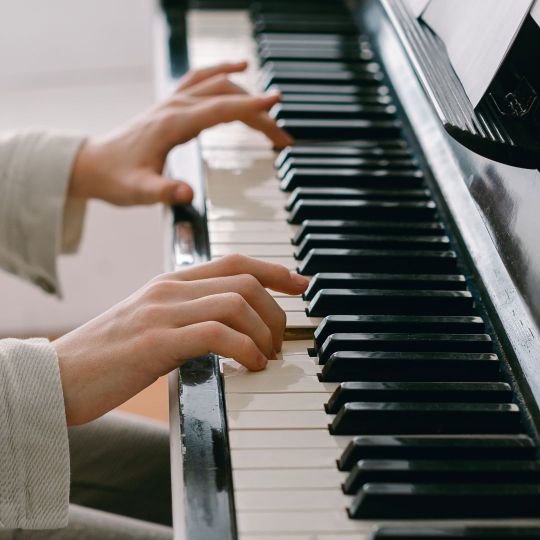
The piano, a widely recognized instrument in Western music, has a rich history that dates back to the early 18th century. It was invented by Bartolomeo Cristofori, an Italian harpsichord maker, around 1700. Cristofori’s invention was a breakthrough in musical instrument technology, as it allowed for dynamic variations in volume and tone. The piano consists of a keyboard with 88 keys, each connected to a hammer that strikes a string when pressed. The black keys represent sharp and flat notes, while the white keys correspond to natural notes. This arrangement aids musicians in easily identifying and playing a wide range of musical tones on the Piano Keyboard. The strings are stretched across a wooden frame, and a soundboard amplifies the sound. The piano’s versatility and expressive capabilities have made it a staple in classical, jazz, and contemporary music.
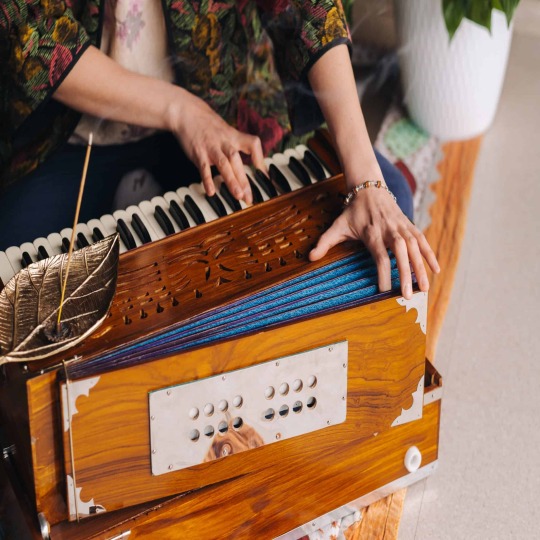
The Harmonium, also known as the pump organ, is a keyboard instrument that originated in Europe during the 19th century. It was developed as a portable alternative to the pipe organ, allowing musicians to create organ-like sounds without the need for a large instrument. The harmonium works by using foot-operated bellows to force air through metal reeds, producing sound when the keys are pressed. It gained popularity in India during the colonial era and became an essential instrument in Indian classical and devotional music. The harmonium’s distinct sound and portability have made it a beloved instrument in various musical genres.
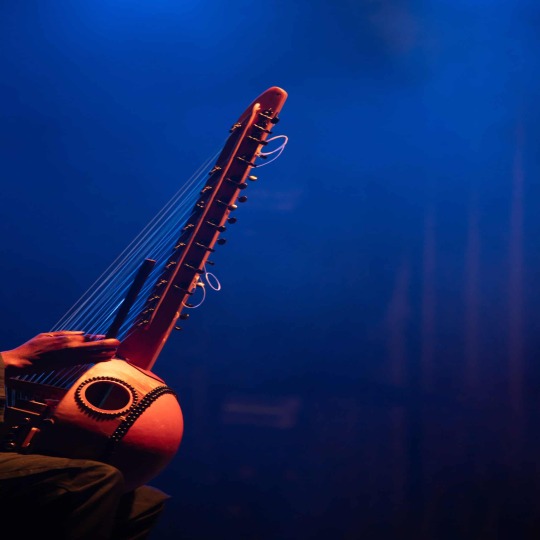
The Sitar also spelt sitar, is a plucked string instrument that is synonymous with Indian classical music. Its origins can be traced back to the 13th century, and it has since become one of the most recognizable and iconic instruments in the world. The Sitar features a long neck with movable frets and a resonating gourd body. It has a varying number of strings, with the most common configuration being seven main strings and several sympathetic strings. The Sitar is played by plucking the strings with a wire plectrum, creating a unique and mesmerizing sound that is characteristic of Indian classical music
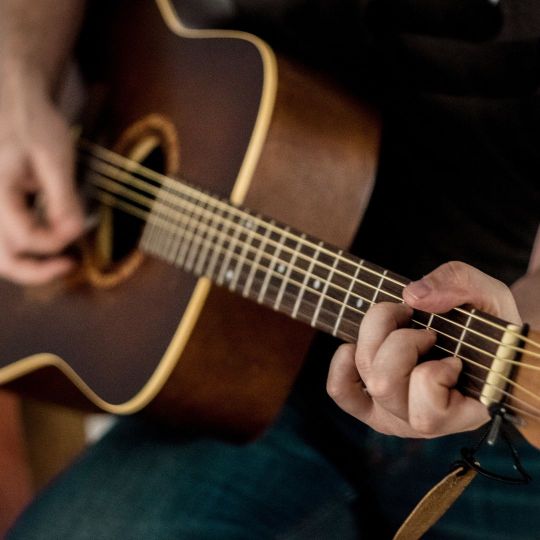
Who doesn’t know about the Guitar? It is one of the oldest and most basic instruments in the music world. It usually has six strings. It is played with both hands by strumming with a guitar pick and simultaneously fretting with the fingers of the other hand. It is one of the famous musical instruments. Playing guitar seems fascinating in movies or dramas but what about turning this fascinating dream into reality? All you need is passion.
Conclusion:
The origin of musical instruments is a testament to the creativity and ingenuity of human beings. The Ravanhatha, Piano, Harmonium, Sitar and Guitar are just a few examples of the diverse range of instruments that have shaped the world of music. Each instrument carries with it a rich cultural heritage and a unique sound that continues to captivate audiences worldwide. Whether it’s the haunting melodies of the Ravanhatha, the expressive versatility of the piano, the soulful tones of the harmonium, or the enchanting sounds of the sitara, these instruments remind us of the universal language of music that transcends borders and connects us all.
#best music institute in mumbai#sound engineering#musicinstituteinmumbai#music institute in mumbai#sound engineering courses near me#best music production course in mumbai#best music school in mumbai
2 notes
·
View notes
Text
What is the process of making a Phad painting?
What is Phad Painting
Phad painting is an Indian folk art form that originates from Shahpura, in the Bhilwara district of Rajasthan. It is a traditional cloth painting, portraying the glorified stories of the local rulers, warriors and deities. The paintings depict stories from Hindu mythology and the epics of Mahabharata and Ramayana, using bold and vibrant colours. The paintings are often accompanied by a recital of religious verses and hymns, using traditional musical instruments.
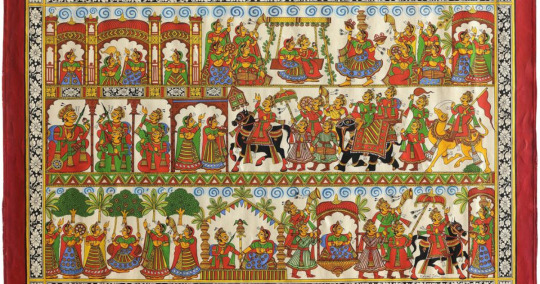
How do you make a Phad painting?
To make a Phad painting in the traditional style, you will need the following supplies:
- A canvas or cloth backing of at least 9 feet by 4 feet in size
- Wooden dowels or sticks of various lengths (at least 2 dowels that are each 6 feet long)
- Paint and brushes
- Scissors
- A ruler
- Basic stationery
The steps involved:
Once you have gathered all of your supplies, you can begin making your Phad painting
1. Cut the cloth backing to the correct size using scissors.
2. Decide where you want to place the main image or story and then measure and mark off that space on the cloth with a ruler.
3. Begin drawing out the image or story onto the cloth using chalk or charcoal pencils. Make sure it is drawn neatly and accurately. If needed, use a light box to help trace any images perfectly.
4. Once the image is complete, start painting it using bright colours and intricate details. Be sure to follow tradition closely for the best results.
5. When finished, attach the wooden sticks perpendicularly along one edge of the painted cloth using strong adhesive tape. These will be used later to roll up and store away your painting when finished.
Story of Phad Painting
The Phad painting has been passed down through generations within a single family for more than 800 years. The Phad painting depicts the story of the local hero Pabuji, who is said to be the reincarnation of God by the Rabaris. These stories are narrated by the Bhopa (priest) and the Bhopi (wife) in a performance with a musical instrument known as ‘ravanhatta’. The Phad is a portable shrine by the Rabaris and is used as a backdrop when the Bhopas recite 4000 verse epics for 5 nights. The Rabaris believe that worshipping the Pabuji ki Phad can cure diseases. Phad paintings depict the stories of Devnarayan, a local deity as well.
Use of Phad Painting
Phad paintings are used for many different purposes, including decorations in homes and temples, as part of wedding ceremonies and festivals, and as souvenirs. Phad has also been used to illustrate folk heroes' stories, celebrate the local culture, and promote the traditional art form. The paintings can also be used as teaching tools to help explain Hindu mythology and traditions to children.
Phad theme and Phad art are so interesting. If you want to learn more download the Rooftop App.
0 notes
Photo

#Music expresses that which cannot be said and on which it is impossible to be #Silent #Ravanahatha #Ravanhatta #stringmusician #stringinstrument Music is #Life #Musician #Player #Jodhpur #Rajasthan #Ajmer #Gypsy #art #Traditional #Wanderlust #Explore #Travel #Discover #Wanderlist #Wanderer #Instagood #Like4like #Likeforlike #Picoftheday #Bestoftheday #Oneplus6 #Cool #Awesome #CapreDiem (at Patwa Haveli,jaisalmer) https://www.instagram.com/p/BombuKjlfbj/?utm_source=ig_tumblr_share&igshid=7dx4kalfqmi1
#music#silent#ravanahatha#ravanhatta#stringmusician#stringinstrument#life#musician#player#jodhpur#rajasthan#ajmer#gypsy#art#traditional#wanderlust#explore#travel#discover#wanderlist#wanderer#instagood#like4like#likeforlike#picoftheday#bestoftheday#oneplus6#cool#awesome#caprediem
1 note
·
View note
Photo




Selection of indian musical instruments, mainly strings and percussions
#sitar#esraj#dilruba#ektara#tabla#dhol#dholki#dholak#pakhawaj#kanjira#dhamru#thavil#Ravanhatta#sarangi#chandra#illustration#watercolor#quentin fovet#fovet
1K notes
·
View notes
Video
Rajasthani Folk Music is a beautiful treat to hear and an electric way to witness the various colourful aspects of Rajasthan. The instrument’s name, Ravanhatta is a corruption of the word ‘Ravan Hasta Veena’. According to legends, Ravana, the demon king of Lanka, from the Ramayana, was a great devotee of Shiva and played the Ravanhatta as a musical offering to the god. The legend goes that after the death of Ravana at the hands of Lord Rama, the Ravanhatta was brought to India from Lanka by Hanuman. However, there is no historical record of such an instrument ever existing in Sri Lanka #folkmusic #roots #culture #ramdevra #tejaji_song #ravanhatta #primitive #streetmusician https://www.instagram.com/p/CEbOGZ5DhiX/?igshid=zf9b0pocimc0
0 notes
Photo

Special artist with special musical instrument named as #ravanhatta #ravanhattaplayer #alankargroup #gofolk #proudtoberajasthani (at Rajasthan)
0 notes
Photo

Just a touch of the hand fills the air with music making the particles dance on the rhythm and connect with no words!!! A rajasthani folk musical instrument #ravanhatta, it produce the most amazing music !! (at Jaisalmer)
0 notes
Text
The word Laadki is a fond way of addressing a daughter. In this brand new composition by Sachin-Jigar, they capture a beautiful conversation between a Father and his daughter. It is the celebration of their unique bond and the journey of a girl growing up to be a woman. The parts of the little girl are sung by Sachin’s daughter Tanishka Sanghvi; while Rekha Bharadwaj has sung the parts of the woman, adding an extended level of charm with her melodic voice. Lending a beautiful touch of Gujarati Folk is Kirtidan Gadhvi, who delivers a sublime vocal performance that transcends the mood of the track. Check out this new track only on Coke Studio@MTV Season 4. Credits - Composed & Arranged by Sachin-Jigar Lyrics - Priya Saraiya Singers -Taniskha Sanghvi, Kirtidan Gadhvi, Rekha Bhardwaj Guitar - Kalyan Baruah Drums - Lindsay D’mello Piano - Rinku Rajput Bass - Jaidep Thirumalai Strokes - Tapas Roy Woodwinds and Gloken bells - Shirish Malhotra Dhol - Ahmed Kanwra & Sajid Kanwra Shehnai - Omkar Dhumal Ravanhatta - Iqbal Warsi Percussion - Naitik Nagda Dholak - Naeem Chorus - Ronkini, Priya Saraiya To set this song as your Ring Back Tunes - SMS 'CS4' to 52040 For songs and videos log on to www.biscoot.com Lyrics - Dori yeh khinchi dori Palne ki tune mori Mere sapno ko jhulaya sari raat Bhale bagiya teri chhodi Bhale nindiyan teri chori Bass itti si yaad tu rakhiyo meri baat Teri laadki main... Teri laadki main... Teri laadki main chhodungi na tera haath Ho... Ho... Mari laadki... O re o parevada tu kaale udi jaaj re Mari haathu rahi jaa ne aaj ni raat Aambli ne peepdi (2) Joshe tari vaat re Bheda madi karshu ame fariyaad Mari laadki ne... Khamma ghani Mari dikri ne... Khamma ghani Mari laadki re e nanakdi phari jhaali le maro haath Mari laadki re... e meethudi ame joshu tari vaat Babul more babul more Itni si araj mori sun le Teri laadki main Rahoongi teri laadli main Kitni bhi door tose main chahe rahoon Zara aanch bhi jo Kabhi aati thi mohe Bhar jaati thi ankhiyan teri jaane hai tu Phir aisa bhi kya tera mujhse bair Aisa bhi kya tera mujhse bair Kar parayi tune mukh liya kyun pher Pass hi apne rakh le kuchh der Udd jaayega paakhi hote hi saver Teri laadki main... Teri laadki main... Teri laadki main chhodungi na tera haath Ae... Sajan tara sambharna haan... Arere mane vayu na ghera vade Mare kaadaj... Kaadaj kere kann hale, Ek ek re aavi chanchu bhare... English Translation - My Darling Daughter You swayed the string, You swayed the string of my cradle You let my dreams swing-along all night long Even though I left your courtyard Even though I caused you sleepless nights I want you to remember my word I am your darling daughter I am your darling daughter I am your darling daughter; I’ll always be there for you. Oh! My darling daughter Oh my little birdie, fly away tomorrow Just be by my side for tonight Even the Tamarind and the Peepal tree Will await your return On behalf of all of them, I appeal Many Blessing to you my darling daughter Many Blessing to you my little girl I wish you could go back in time, be my little girl And hold my hand one more time. My darling daughter My sweet child, I’m awaiting your return. My Dear Dad, If you can please listen to my plea I am your darling daughter I’ll always remain your darling daughter, No matter the distance in between. Even if it was a little scratch, You know your eyes welled up in pain Then what came between the two of us? That you turned your back towards me Let me just be around you for a little more time I’m going to fly away at the dusk of the very next day. I am your darling daughter I am your darling daughter I am your darling daughter; I’ll always be there for you.
4 notes
·
View notes
Photo

The Rajasthani Folk is one of a kind in the world of music. The instrument played here is Ravanhatta. It is an ancient bowed violin. Most folk artists use the instrument for most of their art pieces as they both sit very well together. Really appreciate the contribution of the folk artists in our indian music industry!
1 note
·
View note
Photo

New Post has been published on http://streetiam.com/target/indian-street-music-authentic-music-instrument/
Indian Street Music : authentic music instrument
Ravanhatta player is performing Rajasthani Folk music in Jaisalmer (Rajasthan, India). PLEASE LIKE & SUBSCRIBE: Facebook: http://on.fb.me/Mw7Yaq | YouTube: http://bit.ly/LVWxtJ The Ravanahatha (Ravanhatta or Ravanastron or Ravana hasta veena) is a popular fiddle of western India. Indian Street Music Playlist: http://www.youtube.com/playlist?list=... Click to Subscribe: http://bit.ly/2em85ec Follow us on Facebook: [...]
Click here to view original web page at Indian Street Music : authentic music instrument
0 notes
Text
How to Preserve Indigenous Musical Heritage in India

India’s indigenous musical heritage is a reflection of the country's rich cultural diversity, with deep roots extending into ancient traditions. From tribal rhythms to folk melodies, this heritage comprises a vast array of sounds, instruments, and musical styles that have been passed down orally through generations. However, globalization and modern trends pose significant challenges to preserving these traditions. To prevent the erosion of this invaluable heritage, concerted efforts from individuals, communities, organizations, and the government are necessary.
Let’s explore effective strategies to preserve indigenous musical heritage in India and revive the legacy of native musicians. This article also highlights the role that initiatives like RAAHEIN Gharana can play in safeguarding and promoting these musical traditions.
youtube
1. Know Indigenous Musical Heritage
India’s indigenous musical heritage encompasses the folk and tribal music of various communities across the country. Every region boasts its own musical traditions—each with unique instruments, scales, rhythms, and performance styles. Instruments like the Pungi, Ektara, Ravanhatta, Harmonium, Veena, Tabla, Dholak, Dhol, and Santoor hold cultural significance and are often associated with rituals, festivals, and storytelling.
Historically, this music was part of daily life and served as a means of communication, cultural expression, and spiritual practice. However, the advent of technology, modern entertainment, and the shrinking role of traditional occupations have contributed to the gradual decline of indigenous musical practices.
Read Full Blog: How to Preserve Indigenous Musical Heritage in India
0 notes
Audio
Sabo - Obatala (Nicola Cruz Remix) by SolSelectas SOL 050 - Earth & Sun EP - Sabo Pre-Order: https://ift.tt/2ptB6JS 1. Young Wisdom - Sabo 2. Obatala - Sabo 3. Obatala (Nicola Cruz Remix) - Sabo 4. Young Wisdom (Blond:ish Club Rework) - Sabo 5. Young Wisdom (Birds of Mind Remix) - Sabo Tracks 1,4, & 5 feature Elijah Sage Badua on ravanhatta Tracks 2 & 3 feature Nikila Badua on vocals ✨Purchase / Stream here✨ Bandcamp: https://goo.gl/ja2Uir Spotify: https://goo.gl/EBHlbR iTunes: https://goo.gl/Dq7N3w Beatport: https://goo.gl/fuFieA Traxsource: https://goo.gl/0iQY6D Juno: https://goo.gl/E5JGy9 The 50th release on Sol Selectas Records comes from the label founder himself - Sabo, and features the musical talents of a mother & her son, as represented by the title Earth & Sun. Twenty year old Elijah Sage plays the ancient ravanhatta string instrument on the opening track "Young Wisdom", weaving an emotional mid tempo blanket to lie under the Sun. "Obatala" is the story of the Sky Father Orisha, who creates all human bodies according to Yoruban mythology. The deep tribal groove is complemented by the vocals of Elijah's mother Nikila Badua, representing the roots of the Earth. Nicola Cruz from Ecuador, delivers a stellar remix of "Obatala" taking us high into the Andes Mountains, where organic percussion and live marimbas flow like wind through the valleys. Blond:ish transforms "Young Wisdom" into a psychedelic tech house trip, adding infectious build ups and mind-altering drums for peak time energy. And lastly Paris' Birds of Mind take us on a voyage into deep bliss with their ethereal reinterpretation of "Young Wisdom". The artwork by Helia Jamali, represents the loving balance between the Earth & Sun, and the energy they have created, makes the puppy flower dance in the desert wind. Release date May 12th, 2017 Artwork by Helia Jamali
0 notes
Text
Unravelling the Phad
Unravelling the Phad
As the sun makes its sojourn downward, the delicately folded Phad is unraveled. A Phad is a 15-20 foot horizontal piece of cloth on which an entire folk tale is depicted. The stories commemorate deeds of local heroes. Usually the stories revolve around 2 main folk heroes - Pabuji and Devnarayan-ji.
Devnarayan-ji was a 10th century A.D hero and was known to be an incarnation of Lord Vishnu. His story is said to be very similar to that of Krishna's. Pabuji, on the other hand, was a 14th century A.D hero. He was a local Rajasthani who abandoned his wife at the marriage pyre to keep up his promise of helping a woman from the Charan community save her cows. During his attempt to save the last calf, he died in the battle. According to the folk tale, Pabuji is said to have ridden his horse for close to 10km after his head was slain. A temple was erected where his body finally fell dead. Both the men are titled as 'Cattle Heroes' who vehemently fought for the cows of their community and ended up giving up their lives in the attempt. Cattle heroes are collectively called Bhomiyo. Only some Bhomiyo become famous and achieve divine status.
Today, renowned Phad painting artists like Prakash Joshi, are expanding and exploring the art form further by creating Phad paintings that narrate tales of Durga, Sati, Ramayana, Mahaveer, Buddha and even the Krishna-Leela series.
Till date the origin of the Phad remains a mystery. This is because once a Phad becomes old and worn out it is destroyed by ceremoniously submerging it into the sacred lake of Pushkar. This is ritual is known as Thandi Karna. Hence the earliest specimens of Phad paintings remain unavailable to us. The oldest Phad painting available today belong to the late 19th century.
A Phad is ideally only painted during the monsoon season. This is done with the belief that the folk lords are asleep during this time. Traditionally it is painted only by people of a special cast - Chippa, also called Joshi. Ideally only vegetable colors are used as paint for the Phad. This is because the natural colors remain fresh for a long duration. However, today the scarcities of these natural dyes compel Phad artists to use artificial or synthetic colors. While painting a Phad, only one color can be used at one time. Only once the complete usage of this color is done can the next color begin to be applied.
The initiation of a Phad painting is marked by a ceremony dedicated to Goddess Saraswati. Once a rough draft of the folk tale is drawn and perfected on the khadi cloth, all the figures are given a base color of yellow. This is called kachcha. Finally, the youngest virgin girl of the artist's family is summoned. She makes the very first stroke on the Phad. This ritual is followed by a distribution of sweets.
Every available inch of the khadi cloth is covered with figures. Although the characters are harmoniously painted across the cloth, the significance given to each character depends on the social status and the role that the character plays in the story. Another intriguing feature of a Phad is that, the characters never face the audience. All character represented on the cloth face each other.
A Phad painter does not paint the eyes of the main figure until he hands it over to the Bhopa. The Bhopa is the performer-priest who uses the Phad to perform the tale depicted on it. At the time of handing over of the Phad to the Bhopa, the painter draws the eyes of the main character and adds the name of the Bhopa to the Phad.
Traditionally, the art of painting a Phad was never taught to girls. The painters feared that the skill would stray out of their family when women who were taught the art were sent after marriage into other families. The men would pick up the skill as they would be handed paint and cloth while they were young to experiment and learn with. Most young boys would spend a lot of time around their fathers and thus automatically be gifted with a flair for the art.
Once the Phad is handed over to the Bhopa, the exquisitely painted Phad is brought alive with music, dance and narration. The Bhopas belong to the Bhopa caste and are the men who perform the tale depicted on the Phad. The Bhopa usually adorns a red baga (Skirt), Safa (Turban), a red bagatari (A long Shirt) and ties Ghunghroo(anklets with bells) to his ankles. He uses traditional instruments like the ravanhatta or jantar to sing the folk songs. He is assisted by his wife, the Bhopi, who holds an oil lamp and illuminates different parts of the Phad as the Bhopa sings and dances. Using the intricately designed Phad the Bhopa, the performer priest begins the Phad Bachna - 'Narration of the legend'. The Bhopa usually begins the narration by singing the lura, which refers to hymns of the folk hero. The performance begins once the sun sets and continues till sunrise. It takes up to 4-7 nights of performances to complete the narration of a single tale. Traditionally the Bhopa and Bhopi used to travel from one village to another, pitching their Phad at a central location in the village and performing it for locals.
Unfortunately, today India is left with only about 13 traditional Phad painting artists. People do not understand the value or the intricate work that goes into making a Phad. Prakash Joshi is currently the best known Phad artist in the world. He hails from one of the only surviving families of Phad artists - the Joshi clan. In 2009, he received the National Award (President Award) for his contribution to the dying art form. Prakash Joshi dedicates his time to teaching this traditional art form at Joshi Kala Mandir in Bhilwara, Rajasthan. He travels to 5-6 cities in a year to conduct exhibitions and workshops. Most Phad artists today earn income from exhibitions, workshops and classes. Artists like Prakash Joshi are heartbroken at the current social value of Phad paintings. He believes that the government must put more effort in the form of funding and sponsorship to Phad artists. Phad artists are often called by the government to conduct 3-4month workshops in teaching the art. However, these artists are bound for this time period by a contract that restricts them to take up any other external work in terms of workshops or exhibitions. Prakash Joshi claims that this arrangement is not financially viable for Phad artists as most of their income and networking happen during exhibitions and workshops.
Also, the market today does not give sufficient exposure to the Phad art form. For most consumers the cloth becomes a mere add-on accessory to the interiors of a room. "Majority of my customers today select a Phad based on whether it matches their wall colors or not. I teach my students this sacred tradition in a hope to revive the art in its true sense", claims Prakash Joshi.
It is a pity to note that such a rich cultural legacy is vanishing at such a rapid rate. The creation and presentation of the Phad is more than just an entertaining activity. The entire procedure from the first stroke on the cloth to the last step of the Bhopa is done undertaken with a spiritual dedication. During the performance of the Phad the Bhopa becomes a priest and the Phad becomes a mobile shrine.
Source by Nidhi Suresh
Post Source Here: Unravelling the Phad
0 notes
Photo

0 notes
Video
youtube
Ravanhatta player in Jaisalmer (Rajasthan, India)
ラバンハッタ(ラバナハッタ)の演奏者。
ジャイサルメール(インド、ラージャスターン州)
■ 私家版 楽器事典さんより
インドの弓奏楽器ラバンハッタ(ラバナハッタ)
http://saisaibatake.ame-zaiku.com/musical_instrument/gakki_jiten_ravanhatta.html
Movie from "World Street Music"
0 notes
Video
youtube
Ravanhatta played by a Rajasthani Folk Musician near Jodhpur (by jensdab) Exquisite Musicianship...And so well dressed.
2 notes
·
View notes